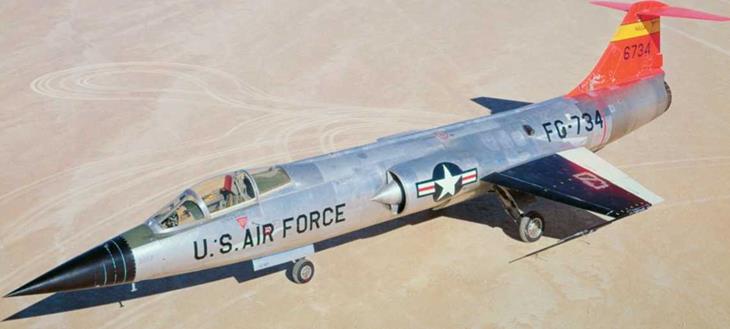CHASE AIRCRAFT
Chase aircraft are high-speed aircraft whose pilots observe the physical status of the X-15 during its mission, principally during its climb with the B-52 and then toward the end of the X-15’s test flight. They are positioned near alternate landing fields, at approach to landing through touchdown, and during the landing run-out.
During the climb, while the X-15 is attached to the B-52 mother ship, the chase pilot observes the X-15’s external features, makes control-
surface checks, and observes any irregularities during the climb. In making control-surface checks, the chase pilot observes the physical deflection of the control surfaces, which for the X-15 are the rudder and the horizontal tail, as deflected by the pilot in the cockpit and observed by the pilot in the chase plane. The pilot in the cockpit cannot see these control surfaces, and so it falls to the pilot of the chase plane to observe them. This check is done before the X-15 is dropped from the B-52. It is an essential safety check; if the control surfaces are not working, the flight is scrubbed.
At drop, the chase pilot watches the engine start up, observes the power levels, notes the clearance from the B-52 as the X-15 separates, and
|
|
is there to assist in descent to landing at Edwards AFB if, for example, the engine doesn’t start and the X-15 heads for an emergency landing at the dry lake designated for that particular launch.
He can note all the external features of the X-15, its sink rate, its progressive proximity to the ground, and anything unusual that would help the pilot during the landing, such as anomalies in configuration if the flaps did not deploy. The chase pilot can quickly land during an accident in order to physically assist or help rescue the pilot. In emergencies, he would perform the same functions when stationed near alternate landing sites.
With flights varying from launch close to Edwards Air Force Base to launch 300 miles distant, different numbers of chase planes were needed. Usually there were four, one for the climb of the X-15 and the B-52 mother ship, another
at drop, one at an intermediate station above an alternate landing field, and one to cover the descent and landing at Edwards. During the most distant launch, an additional chase plane was needed to cover additional emergency field locations. As a result, there were either four or five chase planes used per X-15 flight. These chase pilots were usually other X-15 pilots, NASA research pilots, or Air Force pilots from the Air Force Flight Test Center.
The chase airplanes that were chosen best matched the X-15’s flight characteristics required by the X-15 testing program. For the early flights launched at Edwards Air Force Base, an F-100 answered the call. Later, the team chose a Northrop T-38A because it better matched the B-52’s speed during its right turns. Both the F-100 and the T-38A could fly in the low supersonic

▲ Another view of the X-15 landing with the F-104 chase plane alongside. USAF, Air Force Flight Test Center History Office, Edwards Air Force Base

▼ Another view of the F-104 chase plane. USAF, Air Force Flight Test
Center History Office, Edwards Air Force Base

range, around Mach 1.5. If there was a problem in climb and cruise to launch, the chase pilot was thus in position to help in the landing.
For the launch at a distance from Edwards Air Force Base, an F-104 chase aircraft stayed with the X-15 until it accelerated out of sight. The F-104 was the first fighter airplane capable of sustained flight at Mach 2. The pilot of the F-104 observed the
separation from the B-52 at drop and watched the engine for proper light-up. If the engine did not fire properly, the F-104 would descend with the X-15 to landing and be on hand to help on the ground.
For the chase aircraft covering the intermediate emergency fields, F-104s assisted in the descent and landing of the X-15 and provided any assistance needed after touchdown. These aircraft

delayed their takeoff for about 30 minutes after the B-52 took off so they would have enough fuel to loiter at their positions.
Other flight vehicles participated as well. A helicopter, the Piasecki H-21, ferried personnel to and from emergency fields as required. It also blew fumes away from damaged aircraft, as when Jack
McKay flipped over during his emergency landing. This allowed emergency personnel to extricate him from his airplane and perform other functions during his rescue.
Air Force C-130s transported equipment and personnel to emergency fields, including fire engines. Safety was taken seriously.
X-15 on the lakebed after the flight on October 17, 1961, with pilot Joe Walker still in the cockpit and the Pasecki H-21 helicopter in the background. USAF, Air Force Flight Test Center History Office,


Edwards Air Force Base
|
|
Rear view of the B-52 on the ground with the X-15 attached to its right wing. USAF, Air Force Flight Test Center History Office, Edwards Air Force Base
Support trucks and personnel at an X-15 landing site. USAF, Air Force Flight Test Center History Office, Edwards Air Force Base













